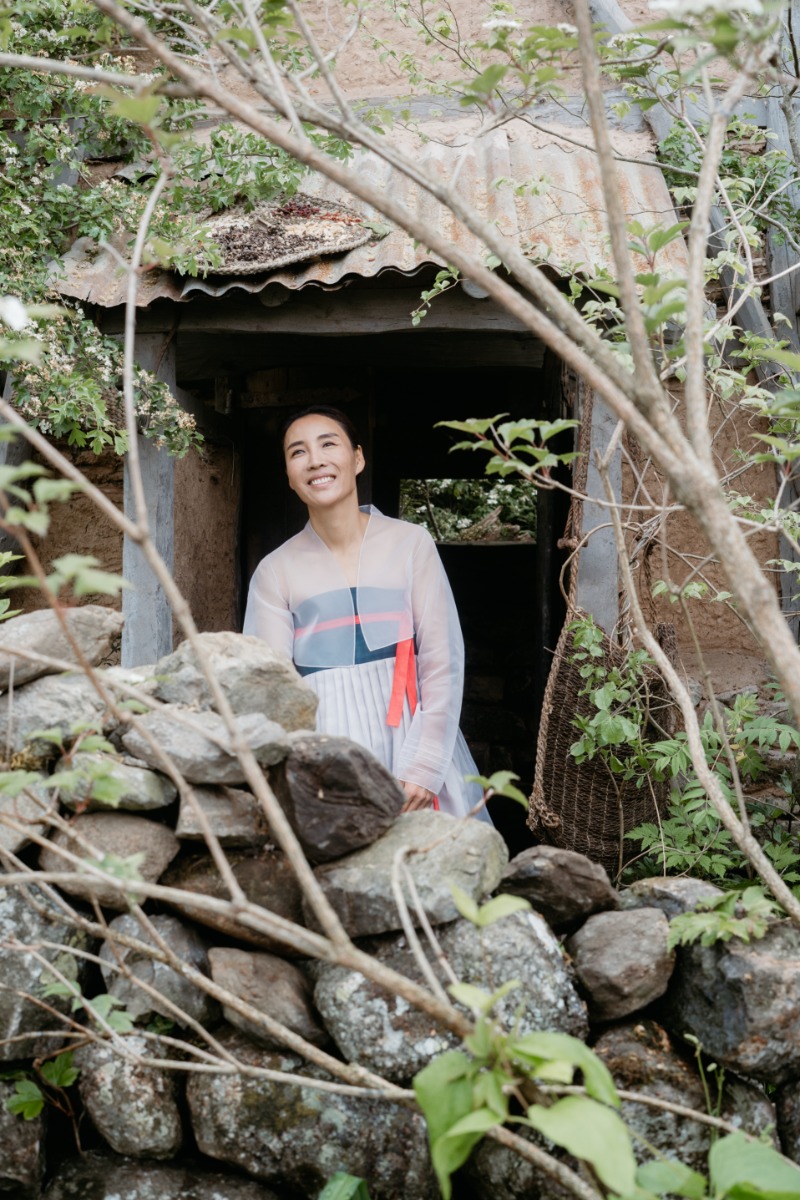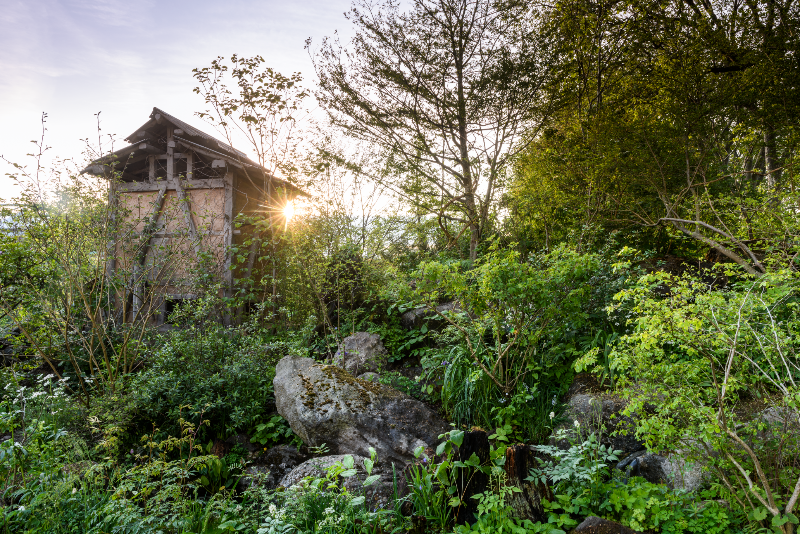 Jihae Hwang Brings Korean Gardens to the World
Jihae Hwang Brings Korean Gardens to the World
1. Please briefly introduce yourself.
I plant flowers and trees, and I’m interested in bringing gardens into the enhanced realm of art. I want to be a part of nature’s work.
2. You made headlines in May by winning the gold medal at the RHS Chelsea Flower Show 2023. Would you share a little about the significance of this award?
The RHS Chelsea Flower Show is one of the UK’s most popular events. Boasting 200 years of history and tradition, it’s a manifestation of the country’s strong soft power and cultural leadership. It’s even mar ked on the royal family’s official schedule. I think I’ve shown the power and potential energy of Korean mountains and fields in my work at the Chelsea Flower Show. I’m just a lucky messenger, delivering materials and environments that are familiar to me. It’s particularly meaningful that the herb drying tower, a component of A Letter from A Million Years Past exhibited at the Chelsea Show, has been moved to and installed at Sandringham House, the country house of King Charles III. I’m glad that visitors to the royal residence will be able to appreciate it in March.
3. Please introduce your work, “A Letter from A Million Years Past.”
Before the existence of hospitals and pharmacies, mountains helped us to take care of our livelihoods, health, and quality of life. I began my garden work with the understanding that mountains used to be our hospitals and pharmacies. We cured illnesses with medicinal plants and survived on nature’s provisions. By referring to the environment in which herbs with medicinal properties grow, I wanted to discuss the impact that the plants’ surroundings have on the human body. By minimizing human intervention and recovering [the land’s] original state, we respect the nature of plants [and allow them] to return to their own primitive state. To me, this restoration to the primeval state forms the foundation for the co-existence of humans and nature.
4. You won the gold medal at the RHS Chelsea Flower Show 2011 with your “Haewooso” garden, becoming the first Korean designer to do so, then went on to win another gold the following year with your “DMZ Quiet Time” garden. This makes your May 2023 gold medal your third Chelsea Flower Show victory. How do you feel about winning these honors in the UK, dubbed the “center of garden culture”?
Ten or so years ago when I was in London preparing for my first exhibition, I went to a print shop to have my design drawing printed. Somebody asked me where I had come from, and I answered, “Korea.” Then they said, “Your country is still at war, isn’t it?” They said it so confidently that I was almost embarrassed. Even then, no one knew about Korean gardens. After three exhibitions, I’m able to talk about Korean gardens a little more comfortably in the UK. I feel grateful that Korean gardens offer an opportunity to let the spiritual power and indigenous philosophy of Korea take root in global garden art history.
5. What is most characteristic of Korean gardens?
About 70 percent of the territory of Korea is forest. Naturally, Korean gardens are characterized by our ancestors’ modest way of life; they adapted themselves and their lifestyle to nature and the inherency of the ecosystem formed by the unique climate conditions of Korea’s four distinct seasons. The beauty of Korean gardens lies in the absence of intention or desire. One could describe this as the beauty of detached observation originating from the surrounding environment: mountains, streams, grass, and plants. There is respect for nature itself. In feeling awe for nature while dreading it as a sort of godly being, Koreans adopted values that accommodate nature and prioritize being flexible. The most impressive comments I heard at the latest exhibition were, “The Korean garden is flowing,” “[The] Korean garden is on the move,” and, “Every time I look at the Korean garden, it looks different and I don’t know why.” I think these s answer your question.
6. Where do you get your ideas? What is the source of your motivation?
I don’t think I’m a particularly creative person. I just want to be a flexible thinker. I want to be supple, open-ended, and more accommodating. I begin with the discovery of “a better me.” I am quite sensitive and easily scared or nervous, but such feelings often become the driving force for me to act boldly. The sense of emptiness and futility I feel is sometimes expressed in the form of drawings. My sources are as ordinary as those of other people. They are everything in my life: happiness, beautiful yet fleeting moments, coming-of-age experiences, memories, and pain. Fresh ideas and clear concepts often come to me while working on a project.
I think the emotions I felt as a child are extremely important as my entire worldview was formed then. The first garden that left a strong impression on me was my mother’s vegetable garden. It was full of red cherries, carrots, and green onion flowers. In early summer mornings, crown daisies and lettuce leaves waved wet with dewdrops. There were also purple bellflowers that my mother planted, whose roots she used to heal my younger sibling’s cough, and the fragrance of deodeok [lance asiabell]. My mother’s garden was the best one I can think of. In it, she grew vegetables for her own children’s health and survival, and it became both my foundation and the force that has sustained me all these years. It was the most creative fairy tale and the best illustrated book of nature.
7. What do you prioritize when designing a garden?
Like architects, I seem to be obsessed by the stories inherent in gardens’ lots. I usually develop a curiosity about who lived there in the first place. A garden is an art that relies on time. I try to design it while picturing how it will look 10 or 20 years later, but only the sun, wind, and birds will know its true face as time, changing seasons, and the ecosystem complete it. It will contain its own story, as told by traces that the sun and wind leave over time. I also imagine that bees, butterflies, and little birds will be happy there. I try to find a non-intrusive way to restore as much of an area’s ecological system as possible. Ecological restoration is my top priority these days. Recently, I think that before discussing aesthetics and art, one should consider and design practical approaches and actions for coming generations.
8. As a world-class garden designer and environmental artist, what are your future plans?
This year, I’ve been invited to the London Design Festival and also plan to present a story of Korean plants at the Victoria and Albert Museum in London. In July, I’ll demonstrate how plants have been coping with environmental and climate change at Singapore Garden Festival 2024. Next year, my collaborative exhibition with fashion designer Paul Smith at RHS Chelsea Flower Show 2025 will convey the message that endangered plants make endangered colors. I also plan to establish a Korean garden on the terrace of the Royal Opera House, the birthplace of performing arts in the UK.
Back home [in Korea], I’ll set up show gardens under a land art concept in Goyang and Jeonju. I’m especially devoted to a project involving the creation of a Korean garden at Gibon [Basics] School, Korea’s first school of philosophy in Hampyeong, Jeollanam-do. Actually, I cherish this project the most. I hope Korea’s spiritual power and philosophy will take root, enabling an exploration of the nation’s uniqueness and its potential within world garden history. I’m considering seriously how to create spaces in which gardens and philosophy interact as a single body.

Jihae Hwang at the RHS Chelsea Flower Show

“A Letter from A Million Years Past” at the RHS Chelsea Flower Show 2023
 KOREA FOUNDATION
KOREA FOUNDATION newsletter
newsletter










